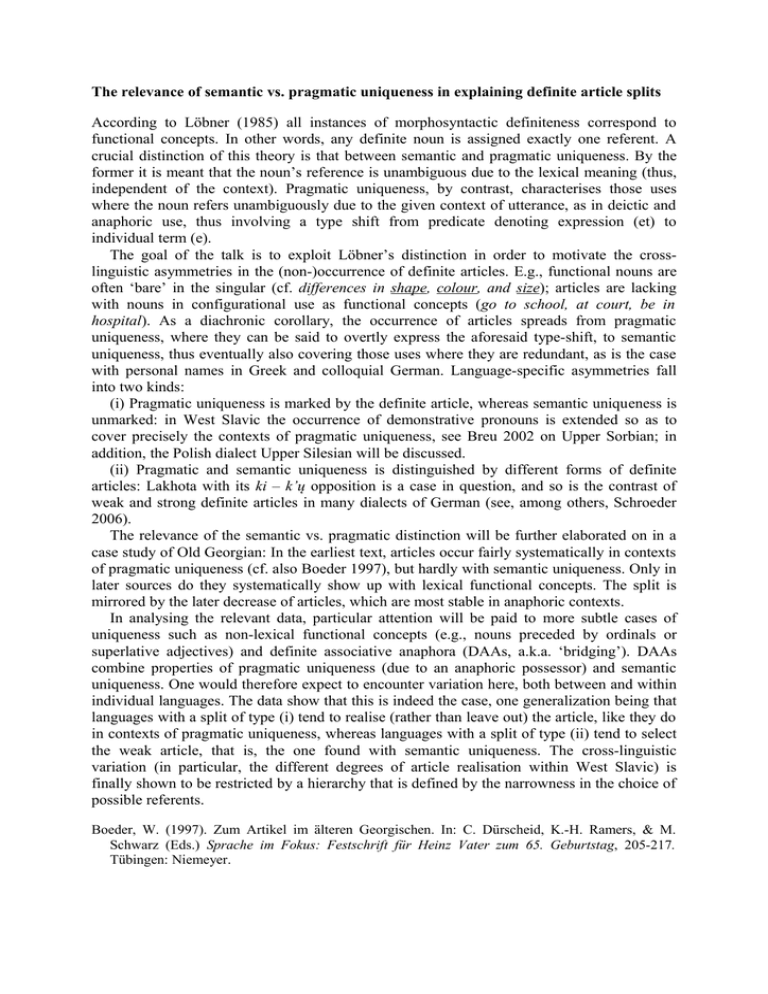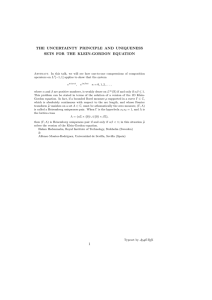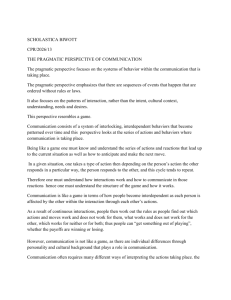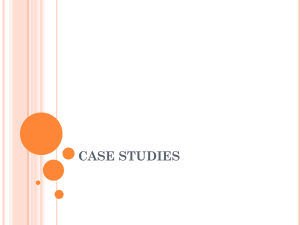The relevance of semantic vs. pragmatic uniqueness in explaining definite...
advertisement

The relevance of semantic vs. pragmatic uniqueness in explaining definite article splits According to Löbner (1985) all instances of morphosyntactic definiteness correspond to functional concepts. In other words, any definite noun is assigned exactly one referent. A crucial distinction of this theory is that between semantic and pragmatic uniqueness. By the former it is meant that the noun’s reference is unambiguous due to the lexical meaning (thus, independent of the context). Pragmatic uniqueness, by contrast, characterises those uses where the noun refers unambiguously due to the given context of utterance, as in deictic and anaphoric use, thus involving a type shift from predicate denoting expression (et) to individual term (e). The goal of the talk is to exploit Löbner’s distinction in order to motivate the crosslinguistic asymmetries in the (non-)occurrence of definite articles. E.g., functional nouns are often ‘bare’ in the singular (cf. differences in shape, colour, and size); articles are lacking with nouns in configurational use as functional concepts (go to school, at court, be in hospital). As a diachronic corollary, the occurrence of articles spreads from pragmatic uniqueness, where they can be said to overtly express the aforesaid type-shift, to semantic uniqueness, thus eventually also covering those uses where they are redundant, as is the case with personal names in Greek and colloquial German. Language-specific asymmetries fall into two kinds: (i) Pragmatic uniqueness is marked by the definite article, whereas semantic uniqueness is unmarked: in West Slavic the occurrence of demonstrative pronouns is extended so as to cover precisely the contexts of pragmatic uniqueness, see Breu 2002 on Upper Sorbian; in addition, the Polish dialect Upper Silesian will be discussed. (ii) Pragmatic and semantic uniqueness is distinguished by different forms of definite articles: Lakhota with its ki – k’ų opposition is a case in question, and so is the contrast of weak and strong definite articles in many dialects of German (see, among others, Schroeder 2006). The relevance of the semantic vs. pragmatic distinction will be further elaborated on in a case study of Old Georgian: In the earliest text, articles occur fairly systematically in contexts of pragmatic uniqueness (cf. also Boeder 1997), but hardly with semantic uniqueness. Only in later sources do they systematically show up with lexical functional concepts. The split is mirrored by the later decrease of articles, which are most stable in anaphoric contexts. In analysing the relevant data, particular attention will be paid to more subtle cases of uniqueness such as non-lexical functional concepts (e.g., nouns preceded by ordinals or superlative adjectives) and definite associative anaphora (DAAs, a.k.a. ‘bridging’). DAAs combine properties of pragmatic uniqueness (due to an anaphoric possessor) and semantic uniqueness. One would therefore expect to encounter variation here, both between and within individual languages. The data show that this is indeed the case, one generalization being that languages with a split of type (i) tend to realise (rather than leave out) the article, like they do in contexts of pragmatic uniqueness, whereas languages with a split of type (ii) tend to select the weak article, that is, the one found with semantic uniqueness. The cross-linguistic variation (in particular, the different degrees of article realisation within West Slavic) is finally shown to be restricted by a hierarchy that is defined by the narrowness in the choice of possible referents. Boeder, W. (1997). Zum Artikel im älteren Georgischen. In: C. Dürscheid, K.-H. Ramers, & M. Schwarz (Eds.) Sprache im Fokus: Festschrift für Heinz Vater zum 65. Geburtstag, 205-217. Tübingen: Niemeyer. Breu, W. (2002). Der definite Artikel in der obersorbischen Umgangssprache. In: M. Krause, & C. Sappok (Eds.) Slavistische Linguistik 2002. Referate des XXVIII. Konstanzer Slavistischen Arbeitstreffens. Bochum, 10.-12.9.2002, 9-57. München: Sagner. Löbner, S. (1985). Definites. Journal of Semantics 4, 279-326. Schroeder, C. (2006). Articles and article systems in some areas of Europe. In: G. Bernini & M. L. Schwartz (Eds.) Pragmatic organization of discourse in the languages of Europe, 545-611. Berlin: Mouton de Gruyter.




